
Team Soak Rochford
Best Moulds for Making Bath Bombs
What is the Best Mould to Use for Bath Bombs?
If you’re just starting out making bath bombs, you may worry that your products won’t be perfect—or won’t live up to the competition. With support from the team at Soak Rochford, you can feel confident in your craft. In this guide, we’re exploring the best bath bomb mould materials to use.
Best Bath Bomb Mould Materials
It’s not just about choosing the right shape—materials also play their part in crafting exceptional bath bombs. Widely available materials include LDPE plastic and silicone. Discover which variety you should use to create perfect bath bombs every time.
LDPE Plastic
LDPE (low-density polyethylene) plastic moulds from Soak Rochford are translucent and made in-house with unique designs.
What Are the Benefits of Using LDPE Moulds?
- Lasts longer: The same material that is used to create playground slides, plastic bags and plastic bottles, LDPE is designed to last. This means you won’t have to keep reinvesting in replacement moulds. They can be used time and again, with little maintenance required to keep them in good condition.
- Soft & flexible material: Their supple nature makes it easy to slip your creations out of the mould once they’re set. No more fuss or broken bath bombs!
- Plenty of shapes: Due to its malleable form, this type of mould can be crafted into pretty much any shape. At Soak Rochford, we like to bring the fun into crafting bath bombs that people want to buy, either to enjoy for themselves or to treat their loved ones. Design themes range from animals to space, and we even have occasion-based moulds, perfect for gifting seasons.
- Versatile uses: From bath bombs to soaps and wax candles, these moulds are suitable for creating a wide range of scented home and beauty products. This material is also safe to use for food products, meaning they can double-up as moulds for chocolate, ice cubes, jelly, and more. However, we’re not sure edible bath bombs are a thing just yet!
- Resistance to chemicals: LDPE offers excellent resistance to acid or alkaline chemicals and oils, meaning they won’t deteriorate when crafting your products.
- Affordable: It’s a relatively affordable and accessible material for moulds, making it a good choice for hobbyists and businesses just starting out. It’s a reliable choice that can provide a good-quality finish every time.
Silicone Moulds
Are Silicone Moulds Good for Bath Bombs?
Silicone is a perfectly fine material to use, but it is best used for simpler designs. More intricate designs have a habit of breaking when being removed from the mould. Instead, we recommend using silicone moulds for other, less fragile products, such as wax melts and soaps.
How Do you Keep Bath Bombs from Sticking in a Mould?
You work hard to produce bath bombs, and the last thing you want is for them to stick to the mould. Our advice? Refrain from packing in too much powder. Pack firmly, but don’t press down too hard.
If you choose LDPE moulds, unmould the bath bombs before letting them dry. Your perfectly formed bath bombs should easily slip out with nothing more than a light tap and wiggle.
Inspired to Get Started?
Watch our video on how to make bath bombs and check out our fun and exquisite bath bomb moulds, used and trusted by hundreds of creators.
